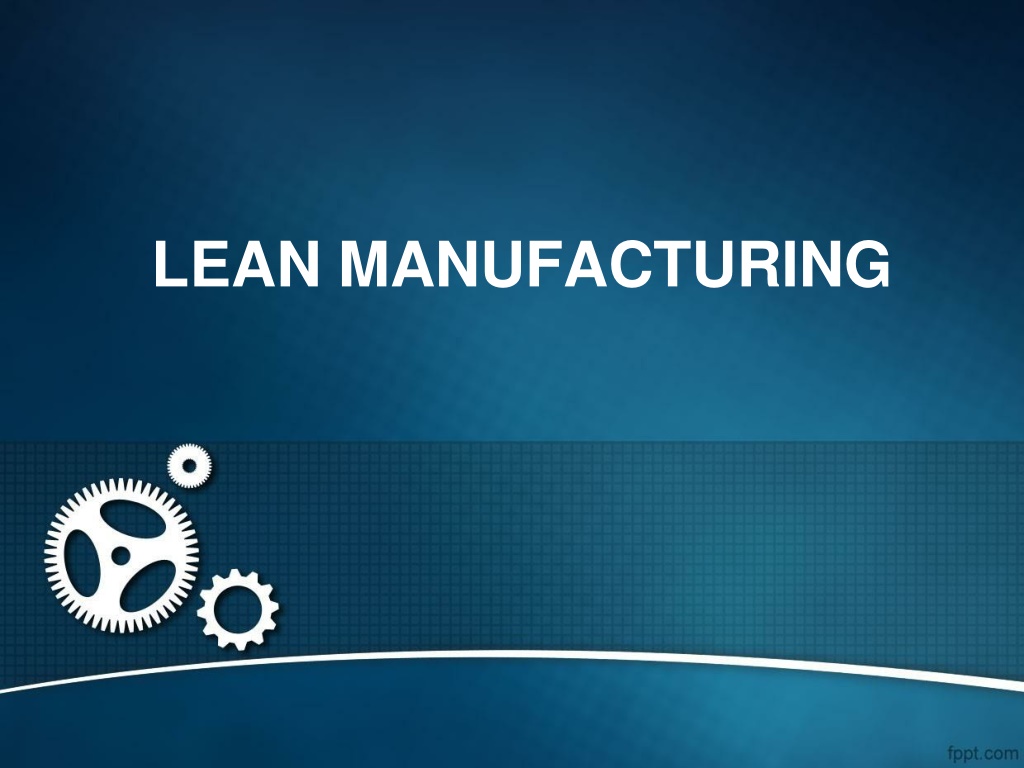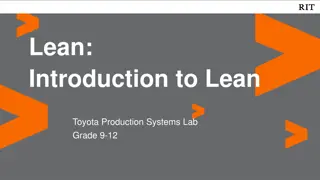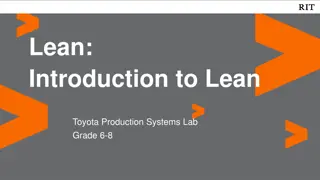Understanding Lean Manufacturing: A Comprehensive Overview
Lean Manufacturing, characterized by the continuous elimination of waste in the production process, aims to improve efficiency, reduce costs, and enhance productivity. Originating from concepts like Flow Production in 1913 and later developed by Toyota, Lean Manufacturing focuses on minimizing non-value-added activities. Through methodologies such as Cellular Manufacturing Systems and Pull Production, companies can achieve significant improvements in labor productivity, lead times, and overall operational efficiency.
Download Presentation

Please find below an Image/Link to download the presentation.
The content on the website is provided AS IS for your information and personal use only. It may not be sold, licensed, or shared on other websites without obtaining consent from the author. Download presentation by click this link. If you encounter any issues during the download, it is possible that the publisher has removed the file from their server.
E N D
Presentation Transcript
What is Lean Manufacturing? Lean Manufacturing, also called Lean Production, is a set of tools and methodologies that aims for the continuous elimination of all waste in the production process. The main benefits of this are lower production costs, increased output and shorter production lead times [1] A systematic approach to identifying and eliminating waste and NVA (non-value added activity) through continuous improvement and flowing the product at the pull of the customer in pursuit of perfection . [2]
History Henry Ford Integrated an entire production process. 1913: Flow Production Problem: No sort of variety. Eiji Toyoda &Taiichui Ohno Reviewed Ford s concepts Toyota Production System The Machine That Changed the World 1990 Lean Thinking 1996
Literature Review L. N. Pattanaik & B. P. Sharma, "Implementing lean manufacturing with cellular layout:a case study", International Journal of Advance Manufacturing Technology (2009) 42:772-779 An applied methodology of scientific , objective techniques to minimize the non-value adding activities. Driven by demand : Downstream to upstream Cellular Manufacturing System (CMS) Machines are grouped Max. Cell independence Reduces Material Handling, WIP Time, Waiting Time, Bottlenecks A case study on implementing a cellular production layout for a series of intermediate production processes at Franklin Corp., a US manufacturer of upholstered furniture, reported a 36% increas labor productivity as a result of implementing a lean manufa uring system. 36% of US based manufacturing companies (2009) Core concept : Pull Production in
Literature Review Report on Introduction to Lean Manufacturing, Mekong Capital Viet Nam, June 2004 Lean Manufacturing: Set of tools and techniques Reduce production costs and WIP Objectives: Defects and Wastage Reduce defects and unnecessary physical wastage Unnecessary features Cycle Times Reduce manufacturing lead times Inventory levels Labor Productivity Reducing the idle time of workers Utilization of equipment and space Eliminate bottlenecks and maximize productivity Flexibility Output To eliminate wastages
7 Types of Waste 1. Waiting Waste 2. Defects and Rejects Waste 3. Inventory Waste 4. Overproduction Waste 5. Over-Processing Waste 6. Motion Waste 7. Transportation Waste
Key Principles of Lean Manufacturing Recognition of waste Standard Processes Continuous Flow Pull Production Quality at the Source Continuous Improvement Latech, US Manufacturing Company after implementing LM Model (Compare to Batch Based Production) Manufacturing space per machine was reduced by 45%; Defects were reduced by 90% Production cycle time was reduced from 16 weeks to 14 hours - 5 days Product delivery lead time was reduced from 4-20 weeks to 1-4 weeks.
Key implications of Lean Manufacturing Traditional batch manufacturing Lean Manufacturing Supply driven Orientation Customer driven Orders are pushed through factory based on production plan/forecast Orders are pulled through factory based on customer/downstream demand Planning Little or no work-in- progress between each production stage Buffer of work-in-progress between each production stage Inventory Materials handed off directly from one production stage to the next Materials after each stage accumulate into works-in- progress storage areas before being retrieved by next production stage Handoff of works in- progress Longer than actual time Production cycle time Shorten
Case 1 In the years of reconstruction following the Second World War, Toyota based in Japan faced a major problem. How to rebuild a shattered manufacturing base without recourse to either the huge market or the economies of scale available to Western (specifically US) companies, and in the face of severe credit restrictions imposed by the occupying forces?
Case Solution and Benefits Taiichi Ohno, the company s Assembly Shop Manager, took in hand the task of redesigning production. Ohno redefined production Toyota Production System clearly focusing on getting the best out of limited investment. Stop if something goes wrong Build only what is needed Eliminate anything which does not add value 1970s saw them overturn the dominance of the local industrial giants Ford and GM. More significantly Toyota and other large Japanese companies expanded in the 1980s to set up new manufacturing centers in Europe and the Americas. The design and development of a new product takes 12 months for Toyot while the primary American and European competitors need 2-3 years to develop a new model.
Case 2 Poli-film America Inc.- a division of a German owned company manufactures protective masking to prevents abrasion and staining of exposed surfaces during manufacturing and delivery. Problem was an enterprise resource planning system that encompassed an unstable database leading to loopholes in inventory management resulting in inefficiency and resource wastage.
Case Solution and Benefits Chose a new program to implement in later 2003 aiming on lean manufacturing principles Greatest impact on company s inventory flow and order distribution Real time traceability allowed to cut down on the 2 mil lbs. of film and other materials by more than half and maintain a sufficient safety stock for when its time to reorder and restock Time and money has seen dramatic cuts Instead of 20 min to fill an order, takes less than 5 min currently Allowed company to expand for more regional coverage Been simplified for reports Reduce time taken to accomplish certain tasks and add more responsibilities
Techniques of Lean manufacturing 1. The Five S Model: Set of Rules to organize each worker s work area for maximum efficiency Sort Sorting what is needed or what is not. Reduce time. Set in order Reduce Motion Scrub (Shine) Remove Dust through painting Stabilize (Standardize) Implement clear procedures for sorting, straightening and scrubbing. Sustain Promote, communicate and train Frequency of usage Arrange essential things in order for easy access. Keep machines and work areas clean
2. Total Productivity Maintenance Includes basic preventative maintenance work Inspection, Cleaning, Tightening and Lubricating Responsibilities given to workers To Identify, monitor and correct the cause of problem Training for higher value added or complicated machines Reduce Machine downtime Increase Machine output or lifetime
3. Cellular Manufacturing Production work stations and equipment are arranged in a product-aligned sequence. Increased production velocity and flexibility Aims to move products through the manufacturing process one-piece at a time, at a rate determined by customer demand (the pull).
4. Just In Time (JIT) - Leverages the cellular manufacturing layout to reduce significantly inventory and work-in-process (WIP). Conditions necessary for the successful: - - - - minimize backups and maximize the efficiency of human and machine labor. - small lot sizes short setup and changeover times efficient and effective quality controls























